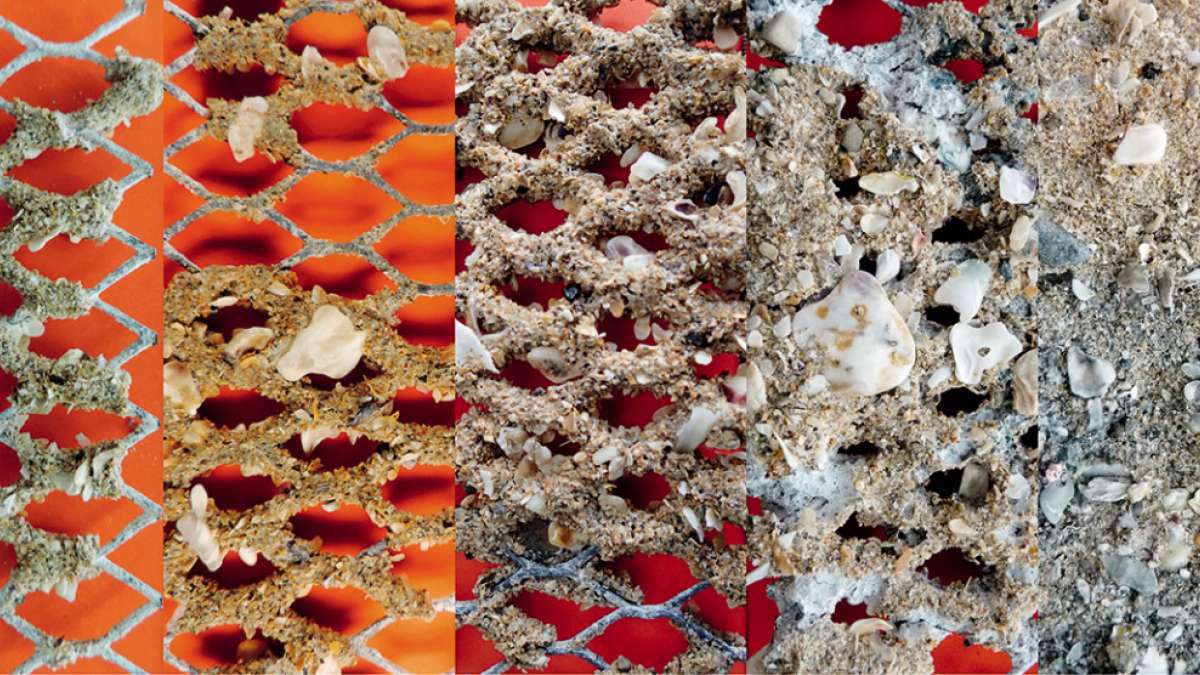DESIGN OF A 2D AND 3D DIGITAL MODEL TO DESCRIBE THE GEOCORAIL PROCESS, AND A SIZING TOOL
The Geocorail process involves forming a rocky conglomerate in undersea environments, thanks to an electrochemical reaction of seawater plus the capture of sediments. Cerema's R&D work is based on the development of a modular electrochemical modelling tool, used notably to size anode and cathode structures.

The need
Coastal erosion affects all France's maritime structures and presents a severe risk to coastal areas. The solution developed by Geocorail involves building barriers, dikes, base supports, foundations, etc., out of a rocky conglomerate produced synthetically using an electrochemical process. The form created in this way is made from, and therefore perfectly suited to, the natural environment. There is no need for the kind of heavy work that generates turbidity phases harmful to marine life.
This start-up, which was present at Cerema's "Biennale des territoires" in 2019, is developing its activity in France and overseas. Although Geocorail has robust feedback from laboratory-based and in situ testing that has helped to validate its technique, development of the process has now entered a phase of improving understanding of the theory behind the phenomenon, and using computational methods that help to optimise the system. Cerema, for its part, has developed its skills in digital modelling of electrochemical processes relating to reinforced concrete, which can be transposed to the issues Geocorail is facing.
The partnership
The research activities are based first and foremost on implementation of electrochemical equations in an open-source library of generic finite elements (GetFeM++) created by the applied mathematics community. This code is not, in theory, intended to be user-friendly for engineering projects, but it offers very flexible implementation for creating coupled models, or for factoring in conditions with specific limits that correspond to the real conditions of the system (e.g. galvanic anode conditions, or conditions of impressed current controlled by intensity or voltage, etc.).
The partnership initially focused on recruiting a digital modelling engineer and having Geocorail conduct technical studies, with Cerema advising on the candidate profile. Subsequently, Cerema trained this engineer in electrochemical equations and digital implementation. The next steps of the work will be the result of sessions in which Geocorail will present its practical issues and will deploy, jointly with Cerema, one or more models intended to improve the sizing of the system (location and geometry of the anodes and cathodes; specification of the electrical wiring, etc.).
The innovation
Beyond the inherently innovative nature of the process, the major innovation of the partnership is the creation of a digital tool that optimises the system by making it simpler to operate, and by ensuring that the geometry is formed in accordance with Geocorail's wishes (verifying, in particular, the thickness of the conglomerate), while providing the best output (e.g. in terms of anode consumption) and creating the formation as quickly as possible.
From a digital point of view, innovation also lies in adapting the methods to a context where multiple spatial scales co-exist in the area of interest (anodes with spacing at metric scale, and cathode protected by a metal wire mesh at millimetric scale...).

A partnership

Cerema collaborates with start-ups like Geocorail in the framework of its CeremaLab support mechanism.
For more info: www.cerema.fr/en/ceremalab
 Institut Carnot Clim’adapt is developing partnership-based research, i.e. management of research work conducted by public sector laboratories in partnership with socio-economic players, businesses of all sizes and local authorities, in order to meet their needs.
Institut Carnot Clim’adapt is developing partnership-based research, i.e. management of research work conducted by public sector laboratories in partnership with socio-economic players, businesses of all sizes and local authorities, in order to meet their needs.
By making use of Cerema’s exceptional resources and regional coverage relating to research, engineering, expertise and equipment, Clim’adapt supports its partners to enable them to transition to a resource-efficient, carbon-free, environment-friendly economy, linked to new life styles engendered by digital transition and adaptation to climate change.
Discover Institut Carnot Clim'adapt


